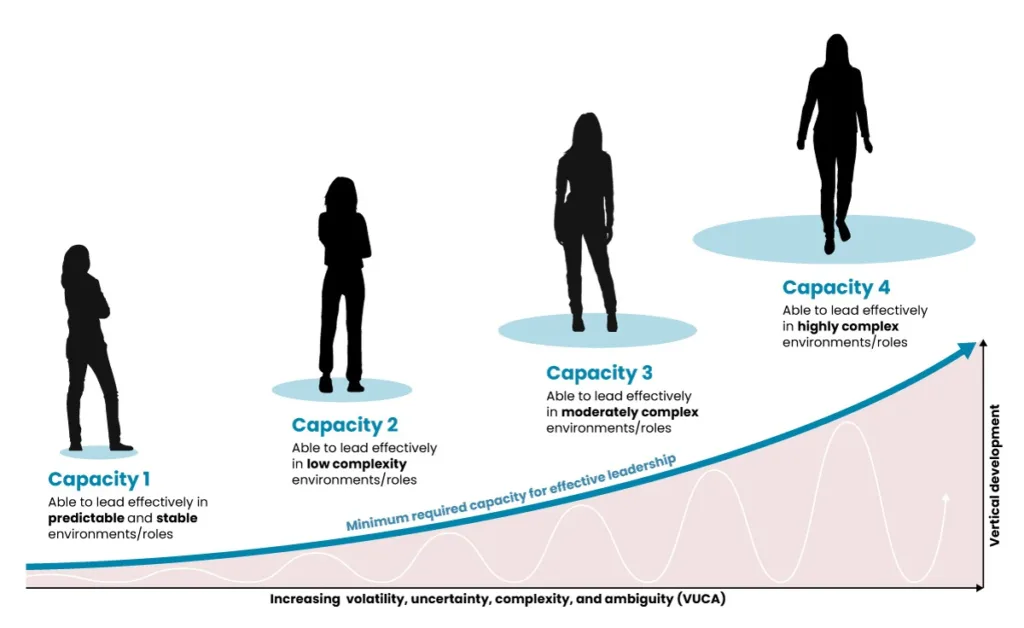Your company invests in leadership training. Excellent trainers, thoughtful content, energized participants. Three months later: same dysfunctional meetings, disengaged teams, and exhausted leaders.
This cycle costs more than training dollars. Each failed program erodes trust, worsens change fatigue, and leaves your best leaders questioning whether real growth is possible. In today’s accelerated pace, organizations can’t afford approaches that don’t stick.
The answer isn’t better content—it’s vertical leadership development. Instead of adding more skills to manage, vertical development transforms how leaders think and respond to complexity. It expands capacity rather than overwhelming it and creates cultures that thrive under pressure instead of cracking.
To see why this approach works, let’s examine where traditional training falls short—and what you can do differently.
Why Traditional Leadership Training Creates Change Fatigue
Most training programs follow the same playbook: learn a skill, practice it in a safe roleplay, head back to work. That’s horizontal development—like downloading another app on your phone. You get more features, but the phone itself doesn’t get faster or smarter.
This approach creates change fatigue: the exhaustion that comes from constantly learning new techniques without developing the capacity to use them effectively. When leaders feel overwhelmed by another framework to remember, another model to apply, they start going through the motions instead of genuinely growing.
Here’s the difference vertical development makes:
- Horizontal: A manager learns a feedback model (SBI, GROW, etc.). They practice the steps but still struggle with difficult conversations because the underlying fear of conflict remains unchanged.
- Vertical: That same manager develops the internal capacity to hold paradox—being both caring AND direct simultaneously. They transform their relationship to conflict itself, seeing it as necessary for growth rather than something to avoid. This isn’t just a new skill—it’s an expanded way of thinking about leadership relationships.
In 2025, with digital and economic disruption coming faster than ever, not pursuing a vertical leadership model will cost organizations. Over 60% of high-potential managers will hit a wall within two years if their growth focuses only on new skills.
Vertical leadership develops the complex thinking and resilience needed for senior roles. When organizations stick to horizontal training alone, promising leaders stall, teams disengage, and culture erodes.
So What Is Vertical Leadership Development?
Now that you’ve seen vertical development in action, let’s explore what makes it fundamentally different. Vertical development isn’t about more information—it’s about transformation. It changes how leaders think, not just what they know.
A vertically developed leader can:
- Stay calm when everyone else is panicking
- See patterns others miss
- Ask better questions instead of rushing to give answers
- Help their teams push through fatigue instead of adding to it

Source: Become a Better Leader in an Increasingly Complex World, Co-Active Training Institute
💡 Try tomorrow: Before your next meeting, ask yourself: “What am I assuming here that might not be true?” (Outcome: You’ll notice blind spots and open up space for new thinking.)
How Leaders Actually Grow Vertically
At Co-Active, we believe growth doesn’t happen through lectures or memorizing models. It happens in the room, in real relationships, through practice that stretches you and reflection that grounds you.
Vertical growth requires three things that define every Co-Active experience:
- Immersive practice. Leaders step directly into live conversations and challenges, not hypotheticals. Growth happens when you feel the discomfort of a real moment—and learn you can stay present inside it.
- Relational connection. Leadership is never a solo act. Our framework develops the ability to shift how you show up with others—whether you’re leading from the front, behind, beside, within, or in the field.
- Faculty excellence. Every program is co-led by two master faculty members. They model the very principles they teach—partnership, presence, and adaptability—so leaders don’t just learn about vertical growth, they witness it in action.
This is how leaders expand their capacity: not by collecting tools, but by transforming how they relate, decide, and show up in the moments that matter.
💡 Try tomorrow: In your next one-on-one, instead of jumping in with advice, ask: “What do you already know about how to move forward?” You’ll see resourcefulness emerge where you used to see dependence. That’s the Co-Active belief—that every person is naturally creative, resourceful, and whole—brought to life.
How Leaders Put Vertical Growth Into Practice
Vertical development isn’t about adding more skills on top of a full plate. It’s about expanding the way leaders show up in different situations. The Five Dimensions of Leadership describe the range leaders can access when they grow vertically:
- Within: Staying grounded in your own values and clarity.
- In Front: Providing direction and painting a clear picture of the future.
- Behind: Encouraging others and giving them the confidence to step forward.
- Beside: Partnering shoulder-to-shoulder as an equal.
- In the Field: Reading the bigger system and sensing what’s emerging.
When leaders rely on only one or two of these dimensions, teams can burn out or stall. But when leaders learn to flex across all five, they create cultures that are resilient, collaborative, and adaptive.
💡 Try tomorrow: In your next team discussion, choose one person who doesn’t usually speak up. Instead of leading from the front, pause and ask them: “What’s your take on this?” Then let the group hear their perspective before moving forward. You’ll be surprised how quickly engagement shifts when different dimensions of leadership are activated.
What Happens When Leaders Grow Vertically
When leaders grow vertically, they stop simply managing tasks and start coaching people. They shift from being directive to being empowering. Instead of telling their teams what to do, they create the conditions where people discover their own solutions, step into ownership, and grow.
This shift shows up in three powerful ways:
Performance
Coaching leaders transfer decision-making and responsibility back to their teams. Performance becomes less about “hitting the target” and more about “owning the outcome.” When people feel trusted to choose how they deliver results, they bring more energy and creativity to the work.
💡 Try tomorrow: In your next project check-in, instead of asking “Where are you at with this?”, ask “What’s the next step you’ve decided to take?” It shifts the tone from accountability to you toward ownership by them.
Wellbeing
When leaders grow vertically, they create supportive, human-centered relationships. They don’t just push for output—they pay attention to the whole person. This improves team wellbeing in real, measurable ways: people feel seen, work toward meaningful goals, and build confidence in their own strengths.
💡 Try tomorrow: Ask one team member, “What part of your work gives you energy right now?” Notice how the conversation changes when people get to name what fuels them, not just what drains them.
Retention
The end result of a leader who invests in growth, listens deeply, and empowers their team is simple: people want to stay. Leaders who grow vertically create the kind of cultures where talent doesn’t just show up—it sticks around. Retention isn’t about perks or pay alone; it’s about the quality of leadership people experience every day.
💡 Try tomorrow: In your next one-on-one, ask: “What’s one thing I could do differently as your leader that would make you want to stay here long term?” Then act on what you hear.
Moving From Tired to Thriving
Change fatigue is the leadership challenge of our time. Skills alone can’t solve it. Leaders need the ability to expand how they think, connect, and respond under pressure. When leaders grow vertically, cultures shift. Trust deepens. Engagement rises. Organizations stop stalling and start thriving.
If you’re ready to explore what this could look like in your own context, the Co-Active Foundations is designed as a hands-on, reflective space to practice these shifts. In just 8 hours, leaders discover how to move beyond fatigue, learn the Co-Active Model, and learn to bring out the best in themselves and others.

